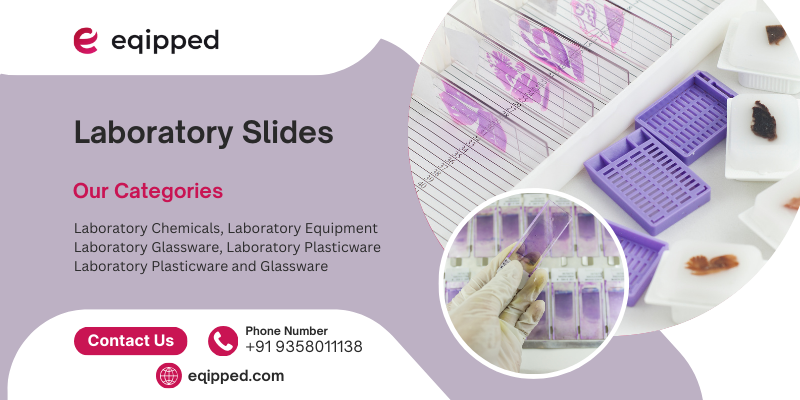Laboratory Slides: Importance, Educational Uses, and Modern Trends in Science Learning

Laboratory slides are one of the most essential tools in the study of biology and life sciences. These thin, flat pieces of glass or plastic form the foundation for observing microscopic specimens in laboratories across schools, colleges, and research institutions. From simple classroom demonstrations to advanced scientific investigations, laboratory slides play a vital role in helping students and researchers visualize the microscopic world. With growing interest in hands-on learning, STEM education, and digital microscopy, the use of laboratory slides in educational environments has become an important and trending topic in modern science education.
In schools, laboratory slides serve as the starting point for young students to explore the fascinating world of cells, microorganisms, and tissues. For many students, their first introduction to biology beyond textbooks comes through observing specimens under a microscope. Using prepared laboratory slides of onion cells, leaf structures, or insect parts, teachers can make science come alive. Instead of reading about plant and animal cells, students can actually see cell walls, nuclei, and other microscopic details. This direct observation helps bridge the gap between theory and practice, making learning interactive, engaging, and memorable.
At the college level, the use of laboratory slides becomes more specialized and analytical. Students in fields like microbiology, zoology, botany, and biotechnology rely on slides to conduct in-depth studies and research. Laboratory slides are used for preparing both temporary and permanent mounts of biological specimens. For instance, in microbiology labs, slides are used to observe bacteria, fungi, and protozoa through staining techniques such as Gram staining. In pathology and histology studies, students use laboratory slides to examine tissue sections, blood smears, and cellular abnormalities. These practical exercises not only strengthen their understanding of biological structures but also prepare them for careers in medical and scientific fields.
One of the major trends influencing education today is STEM-based learning (Science, Technology, Engineering, and Mathematics). Laboratory slides are integral to the science component of STEM education. Through microscopy, students learn how to collect, prepare, and analyze specimens, building critical observation and analytical skills. The process of handling slides, using microscopes, and recording results also enhances coordination, patience, and attention to detail—qualities essential for scientific investigation. By engaging in such practical work, students move beyond rote memorization and develop a deeper appreciation for scientific processes. Laboratory slides thus serve as tools of discovery, inspiring curiosity and scientific thinking.
A growing trend in educational institutions is the use of digital microscopes and smart slides, which combine traditional microscopy with technology. These modern systems allow specimens on laboratory slides to be viewed on computer screens, shared digitally, or projected in classrooms for group learning. Teachers can use these digital slides to explain complex structures interactively, zooming in to highlight details and saving images for future reference. This integration of digital tools not only enhances understanding but also prepares students for the technologically advanced laboratories of the future. The blend of traditional laboratory slides with digital imaging is revolutionizing how biology is taught and learned in schools and colleges.
Another important aspect that makes laboratory slides relevant in education today is safety and accessibility. Glass slides have been traditionally used due to their clarity and precision, but in school environments, especially at the beginner level, plastic laboratory slides are gaining popularity. These slides are lightweight, durable, and shatterproof, minimizing the risk of accidents. Younger students can safely handle plastic slides during practical sessions, making science more approachable and less intimidating. The availability of pre-prepared slide sets also helps schools conduct demonstrations without the need for complex specimen preparation, ensuring both convenience and safety.
In the field of biology education, laboratory slides are also promoting interdisciplinary learning. While their primary use is in biology, they are equally relevant in environmental science, medical studies, and forensic investigations. For example, environmental science students can use slides to examine water samples for microorganisms or pollutants. In forensic science education, slides are used to analyze hair, fibers, and trace evidence. Even in materials science, laboratory slides assist in studying the structure of synthetic or natural materials. This cross-disciplinary use demonstrates how laboratory slides support broader scientific exploration beyond traditional biology.
With the increasing focus on sustainability, another trending topic in laboratories is eco-friendly practices. Schools and colleges are becoming more conscious of waste reduction and safe disposal of materials used in experiments. Laboratory slides, especially reusable ones made of durable glass or recyclable plastic, contribute to sustainable laboratory management. Institutions are now investing in high-quality slides that can be cleaned and reused multiple times, reducing both cost and environmental impact. This aligns with the broader global goal of integrating sustainability into science education, teaching students to conduct experiments responsibly and ethically.
The use of prepared slides is also on the rise in educational institutions. Prepared laboratory slides come with professionally mounted specimens, such as plant tissues, insect wings, human blood cells, and bacteria cultures. These slides save teachers and students significant time, allowing more focus on observation and analysis rather than specimen collection. Moreover, prepared slides ensure consistent quality and accuracy, which is especially important for examinations and demonstrations. As technology advances, manufacturers now offer sets of prepared slides designed specifically for school and college curriculums, making science education more efficient and standardized.
Laboratory slides also play an essential role in developing scientific skills among students. When learners prepare their own slides—whether it’s a drop of pond water or a slice of plant tissue—they practice fine motor skills, patience, and critical observation. They learn to follow systematic procedures, handle instruments carefully, and record findings accurately. These experiences go beyond the classroom, shaping analytical thinking and precision, which are invaluable skills in both academic and professional life. Colleges often use slide-based experiments as part of assessment programs, helping students demonstrate their ability to perform laboratory techniques independently.
In recent years, virtual microscopy has become another educational trend connected to laboratory slides. Virtual microscopy uses high-resolution digital scans of slides that can be accessed and studied online. This approach allows students to explore detailed specimens without needing a physical microscope. During remote learning periods, many schools and universities adopted virtual slide libraries to ensure continuity in practical education. This innovation has made scientific learning more flexible and inclusive, especially for students who cannot access physical laboratories regularly. It represents the future of microscopy education, blending the best of technology with the timeless value of laboratory slides.
Furthermore, laboratory slides play a crucial role in promoting scientific curiosity and innovation among young learners. By observing the unseen world, students begin to ask deeper questions—how cells function, how microorganisms behave, and how living organisms adapt to their environments. Such curiosity forms the foundation of future research and innovation. When schools and colleges encourage slide-based experiments, they nurture a generation of thinkers who are not just learning science but actively engaging with it. Laboratory slides thus become more than educational tools; they become instruments of discovery and inspiration.
In conclusion, laboratory slides hold immense educational and scientific importance. They are not just small pieces of glass or plastic—they are gateways to understanding the microscopic universe. From school classrooms to advanced research labs, these slides enable students to explore, analyze, and appreciate the intricate details of life and matter. With trends such as STEM education, digital learning, sustainability, and virtual microscopy shaping the future of science, the role of laboratory slides continues to expand. Whether used in traditional experiments or integrated with digital technology, laboratory slides remain a timeless symbol of curiosity, discovery, and the endless pursuit of knowledge.








